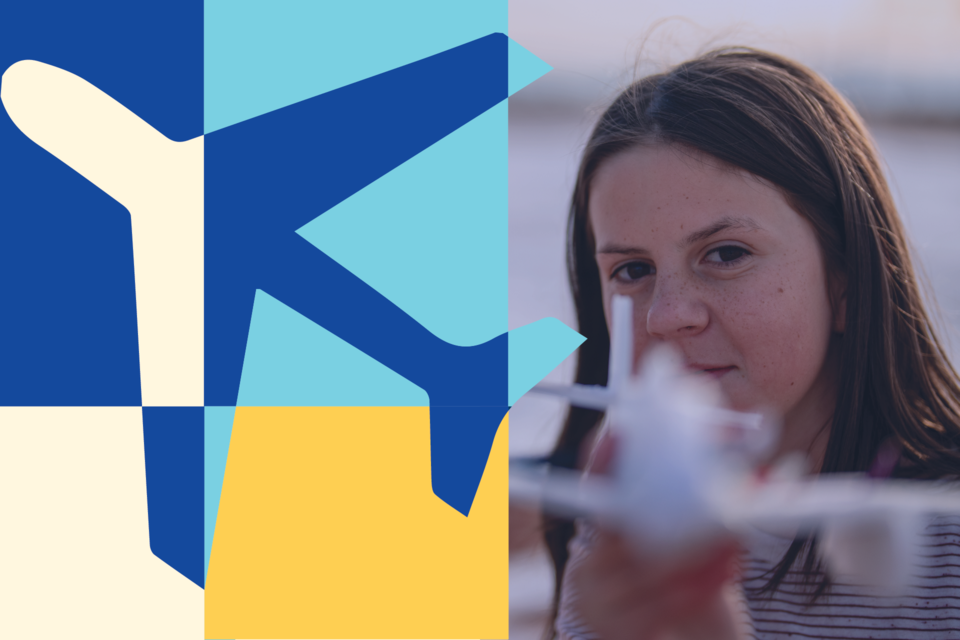At Vance Brand Airport in Longmont, Lizbeth Lara Mosqueda settles into the small cockpit of a Piper airplane. She inserts the key into the ignition, and as she engages the starter, the propeller begins to spin. While the engine warms up, she carefully runs through the pre-flight checklist to ensure that all systems are functioning properly. Skillfully guiding the plane down the runway, she gently pulls on the yoke, lifting the wheels off the ground. Mosqueda ascends into the sky, embodying the very essence of dreams taking flight.
During her sophomore year at Longmont High School, Mosqueda, a 2022 graduate, shared her dream of becoming a pilot with her assistant principal and school counselor. Fueled by her determination to prove that extraordinary achievements are within reach for everyone, Mosqueda set her sights on the skies. With guidance and support from teachers and staff at Longmont High and the Innovation Center, she made her dream come true, earning her pilot’s license at the age of 19.
To become a pilot, Mosqueda completed the Pilot Pathway, one of two aeronautics pathways offered at the Innovation Center. Supported by Aims Community College, the Pilot Pathway focuses on the ground training needed to pass the Federal Aviation Administration (FAA) Private Pilot written exam. With the support of qualified staff and industry-certified flight instructors, student pilots gain a head start toward becoming commercial pilots or FAA ground instructors.
Mosqueda’s journey in aviation began with drone flight training classes at the Innovation Center. From there, she progressed to Pilot Ground 1 and 2 courses, which included operating flight simulators. “That taught me so much and prepared me to fly actual planes. Our instructor took us on amazing field trips to meet pilots who showed us how to preflight planes and how they’re built.”
After graduating from high school, Mosqueda enrolled at Aims where she completed private pilot training. “Learning the steps to land the plane was easy; the hard part was actually landing the plane. It took me about two months to really butter my landings, but once I did, my sleeping brother in the back of the Piper said he didn’t feel a thing,” shared Mosqueda. “The first time I flew solo, it was the best feeling ever, and I imagined how proud all the people who believed in me would feel.” Originally aspiring to be a commercial airline pilot, Mosqueda now wants to become a Certified Flight Instructor and help others achieve their dream of flying.
Opportunities for Aspiring Aviators
For students who are interested in aeronautics, the Erie High School Academy of Engineering and Aerospace offers a comprehensive four-year pathway. The academy advances students’ understanding of atmospheric and space flight fundamentals. “Our pathway program is designed to equip students with industry-ready skills and certifications, providing them with a competitive edge in today’s job market,” shared Robotics and Engineering Teacher Chris Schmitz. “This comprehensive program offers a blend of theoretical knowledge and practical experience, ensuring students are well-prepared for their future careers.”
Erie’s Academy of Engineering and Aerospace provides students with a competitive advantage and opens doors to post-high school success. “We focus on providing students with real-world experiences and the opportunity to earn industry certifications, setting them up for a successful career in their chosen field,” explained Schmitz. “Our students don’t just learn about engineering; they experience it, gaining invaluable hands-on experience that sets them apart from others.”
Positioning herself for success in both college and her future career, Erie High School senior Abigail Umbenhouer enrolled in the Academy of Engineering and Aerospace as a freshman. “The challenging courses in math, science, and engineering have prepared me to continue my education and pursue a career in a STEM field,” said Umbenhouer. “The knowledge I’ve gained through the program, along with hands-on experience, has enhanced my understanding of engineering concepts and given me opportunities to apply what I’ve learned in the real world.”
At Westview Middle School, students with an interest in aeronautics have the opportunity to explore the subject early on. A new aeronautics course, developed by Math Teacher Gene Kath, was designed to provide students with a solid grasp of aeronautical principles and spark their interest in the field. According to Kath, “We start with basics like designing and testing paper airplanes for distance and airtime, and as the semester progresses, students advance to constructing more sophisticated airplanes, including those with motors.”
Motivated by his interest in airplanes and a dream of becoming an aerospace engineer, seventh-grader Bodhi Chittick enrolled in Westview’s aeronautics class. The course has been instrumental in developing his understanding of aviation. “Building planes is fascinating,” shared Bodhi. “Last week, we explored various wing designs, like inverted gullwing, high wing, and mid wing. I’m excited to learn more about real planes and their functions.”
Westview’s aeronautics class is the first middle school aeronautics program in the district. It is offered as a seventh-grade STEM elective, but it will be expanded into a club in 2024. Kath is also partnering with the Innovation Center to develop a middle school program that will give students a glimpse into the high-level aviation projects and opportunities awaiting them in high school.
Through the aeronautics programs in St. Vrain Valley Schools, students gain hands-on experiences beyond traditional classrooms. From drone flight training to piloting real planes, they acquire the skills necessary for success in the aeronautics industry. Reflecting on her journey from student to pilot, Mosqueda is grateful to the staff at Longmont High for their support. She appreciates St. Vrain Valley’s aeronautics programs because they play a role in shaping the dreams of aspiring aviators. “The Innovation Center will always have a special place in my heart because it showed me the paths I could take after high school,” said Mosqueda. “I advise students to follow their hearts and do what they think is best for them. I entered aviation without much industry knowledge, but if I can become a pilot, they can too.”



